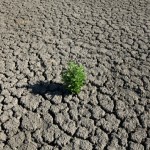5 Things You Might Not Know About the State Water Plan

Photo by Ronald Martinez/Getty Images
One source of water in the Texas State Water Plan involves "seeding" clouds to create more rain.
The Texas legislature got underway this week, and one bit of spending that many seem to agree on, regardless of their political stripes, is water. Several proposals call for funding the 2012 State Water Plan, a bottom-up approach to Texas’ water needs. It relies on regional districts to come up with a wish list of projects that will provide the growing state with enough water for the next 50 years.
The water plan calls for a variety of techniques to harness more water in the coming decades, from new reservoirs to conservation, and some of the ideas are more offbeat than others. We’ve culled a handful of the more novel and obscure methods outlined in the plan.
- Weather Modification: Cloud seeding involves blasting silver iodide, a chemical with similar composition to ice, into a thunderstorm, thereby increasing the cloud’s ability to produce rain. It may sound like science fiction, but it’s already being done around the world, particularly in China (and even here in Texas). Starting in 2020, the water plan earmarks about 15,000 acre-feet (or 4,8 billion gallons) of water to be procured each year through weather modification or cloud seeding. Most cloud seeding taking place in Texas today is done East of the Interstate-35 corridor. There’s just one (fairly significant) drawback: if there aren’t any rain clouds to seed, like much of the summer of 2011, there’s not much seeding can accomplish.
- Brush Control: The water plan calls for the targeted removal of water-hoarding brush and trees, namely the widely-ridiculed and famously-allergenic Ashe Juniper, or cedar. By culling cedars and other water-gulping plants, the water plan says Texas could gain another 19,000 acre-feet of water per year. Problem is, not everyone agrees native cedar trees are such a water-sucking problem. Also, while it might help increase runoff into creeks and hasten the recharge of aquifers, brush control only works when it rains. The water plan recommends brush control mainly in the western half of Texas where cedars are more prevalent.
- Aquifer Storage and Recovery: Aquifer storage and recovery (also known as ASR) turns the notion of how to use an aquifer on its ears. Instead of pumping water out of aquifers, we’re going to start pumping it in. By injecting potable water into viable underground formations, the water remains safe from the ravages of evaporation and contamination that can occur on the earth’s surface. The water plan says storage and recovery could account for about 81,000 acre-feet of water per year by 2060. That’s about half the water that the entire City of Austin used in a year from the Highland Lakes during the record drought year of 2011. That same year, more water evaporated from the Lakes than the City used. Not just any aquifer will work for ASR. The aquifer being used cannot be used or accessed by anyone other than the utility doing ASR.
- Rainwater Harvesting: It’s a technique as old as mankind. Rainwater collection systems run the gamut, from a barrel beneath a gutter to Texas A&M University’s multimillion-dollar Agriculture and Life Sciences Facility, equipped with rain canopies and a 40,000 gallon underground tank. And the Texas Water Development Board has researched implementation of neighborhood-wide harvesting schemes. The City of Austin, and several other Texas towns, offer rebates on rainwater collection equipment. Unfortunately, you can only harvest as much rain as the weather affords. Roofs are prime harvesting locations, so the highest concentration of rainwater harvesting will likely occur in municipalities and urban areas, though it has seen use in less-developed parts of Texas where drilling a well can be costly, like the Hill Country.
- Conservation: A drop of water saved is a drop of water earned. Water conservation occurs on all levels, from low-flow toilets to government programs promoting water-friendly power generation. Urban conservation could account for up to 650,000 acre-feet of water saved by 2060. Total conservation could account for up to 1.5 million acre-feet, according to the water plan. In all, conservation makes up 34 percent of the state’s new water supplies by 2060. A significant portion of conservation will be irrigation conservation (17 percent), which means agriculture and farmers will be able to grow more while using less water.

